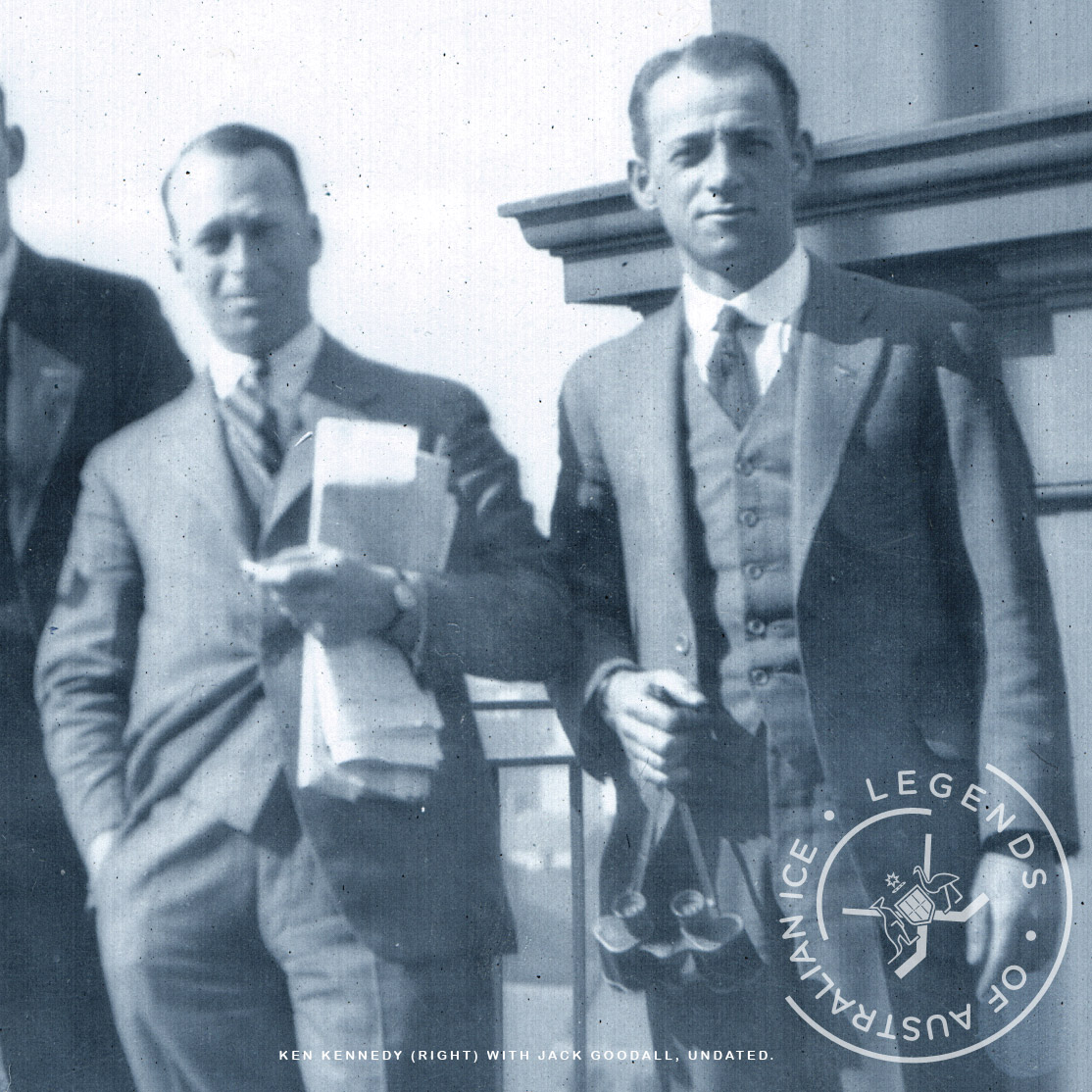

[Top] On right with John Goodall, undated. Jack Gordon Collection. [Beneath] Caricature from Referee newspaper, 1936.
CAREER SUMMARY
Birth
September 6th 1913
Sydney NSW Australia
Death
August 20th 1985 (71)
Sydney NSW Australia
Clubs
NSW Eastern Suburbs, ENL Warwickshire, ENL Worcester, ENL Birmingham Maple Leafs
Goodall Cups
1931, '32 (tie), '33, '34, '48
Australian Speed Skating Champion
Quarter- and One-mile: 1931, '32, '33, '34 (Speed Skating)
English League Champion
1935-6 (Ice Hockey)
British Speed Skating Champion
1935, '37
Olympics
500m 29th, 1500m 33rd, 5000m 33rd (speed skating)
Life Membership
NSW Association, national association
President, national ice hockey association
Namesake, AIHL Finals MVP Trophy
Australian Ice Racing Roll of Honour
Sport Australia Hall of Fame
BORN SEPTEMBER 6TH 1913 in the family boot shop in Sydney, he was the son of Eva and Jack, a surgical bootmaker who served as vice-president of the NSW ice hockey association. Ken had two sisters, Clarence and Kathleen, who were both very good figure skaters. Kath was three times Australian Senior Ice Dance Champion with Syd Croll (1933, '35, '36). A speed skater and ice hockey player with one of the highest profiles ever in Australian winter sports, he started ice hockey in 1928 with Sydney's Eastern Suburbs, founded and captained by Canadian expat Jim Kendall. Coached by Kendall, he debuted as a 17 year-old just three seasons later in the 1931 Goodall Cup which New South Wales won. He won four straight Cups (1931, '32 (tie), '33, '34), and another when he returned from England after the war. He was the Australian quarter-mile and one-mile champion speed skater from 1931 through to 1934. His personal bests were 500m: 47.4 (1936); 1500: 2:31.8 (1936); 5000: 9:48.9 (1936).
In December 1934, he travelled overseas for more specialised training and competition, and first raced in the British Indoor Speed Skating Championships in which Jimmy Brown had earlier competed. He won the half-mile and one-mile titles, establishing record times in 1935 and 1936. He won the 1935 one-mile British title in 3m 7s. He became the first Australian Winter Olympian at age 22 and the sole member of the first Australian Winter Olympic team in 1936, competing in the 500m, 1500m and 5000m long track events in the twin Bavarian towns of Garmisch-Partenkirchen, Germany. There were 52 competitors at the 1936 Games, and his best results were 29th in the 500 metres, 33rd in the 1500 metres, and 33rd in the 5000 metres.
He won the British one-mile title back in 1937 in 3m 13s at Harringay Arena in England, learned a trade with a Birmingham jeweller and played Division I hockey in the English League between 1934 and '37. He played for Warwickshire, Worcester, then back to Warwickshire for a season as the renamed Birmingham Maple Leafs, winning the English League Championship (1935-6 season) when it was biggest amateur league in the world. Great Britain had competed in international ice hockey since 1910, including the victorious 1936 Olympic Games campaign where it captured the Triple Crown of World, Olympic and European ice hockey titles.
Kennedy married 23 year-old Elizabeth Jessie Somerville at Blackpool England on July 11th 1938. Elizabeth was a silver medallist for Great Britain, and the couple met while skating in an ice show. They lived in Bournemouth England until their return to Australia with two children, John and Dorothy. A third child, Cheryl Elizabeth, was born in Sydney in 1949. [6]
When Birmingham abandoned hockey, Kennedy turned to professional skating. He joined the traveling troupe of Australian world professional pair-skaters, Enders and Cambridge. He earned AU£75 per week when "the basic wage was 50 bob" (about AU£2.5). He featured in ice shows, did barrel jumping and served in the Royal Air Force throughout the war. On his return to Australia in 1946 he renewed his involvement with speed skating and ice hockey, winning further speed titles and representing his state in ice hockey from 1947, until his retirement in 1953 at the age of forty.
From 1952 until 1964, he was president of the renamed Australian Ice Hockey Federation, which had first formed in 1923 as the Ice Hockey and Speed Skating Council of Australia with John Goodall as president.
Kennedy was also AIHF delegate to the Australian Olympic Federation, where he argued that overseas trips would be needed for Australia to reach world standard. His post-Olympic contribution to speed skating and ice hockey was life-long. In the 1980s, he still skated and owned an ice skating equipment shop near the former Glaciarium. He ran this family business into his seventies, serving the personal skate requirements of many Australian skaters.
Kennedy's wife Elizabeth died in September 1967, and he married Fay Vivienne Sparkes on September 24th 1971. [6] In 1983, he had a trophy named after him for the televised Slapshot 83 tournament in Sydney. After his death on August 20th 1985 at the age of 72, his family donated a perpetual trophy named in his memory for the "Most Sportsmanlike" player of the Brown Tournament. Another in his name was awarded to the Most Valuable Player of the AIHL Finals since 2010. During his term of office with both state and national associations, Australia sent its first ice hockey team to the 1960 Winter Olympics, and to the World Ice Hockey Championships in 1962.
A Life Member of the NSW association in 1954 and the national association in 1964, he was the first inductee to the Australian Ice Racing (AIR) Roll of Honour and the Sport Australia Hall of Fame for speed skating on December 9th 1986. His daughter Cheryl and son John attended a ceremony at Melbourne's Icehouse where their father's Olympic sash with swastika buckles is on loan. They also visited the Sportsman's Hall of Fame at the MCG in Melbourne where their father is honoured with display memorabilia. [6]
Filmed at Kennedy's Skate Shop, Kent St Sydney, Australia, 1983. Courtesy Cheryl Cook.
[1] Although Kennedy was the only member of the first Australian Winter Olympic team, his entry received official backing from the Australian Olympic Federation, who said: For the first time in Olympic history Australia will be represented at the Winter section of the Olympic Games. The Executive Committee has carefully considered and endorsed the entry of Kenneth G Kennedy to represent in the Ice Speed Skating events. The NSW Olympic Council reported: [He] ... has the honour of being the first representative chosen for the winter section of the Olympic Games ... [He] amply justified his nomination. "They were magnificent," he said of the games in Nazi Germany "well staged and closely policed by the army. Wherever you went there were guards ... the army. They did not interfere but you knew they were there to keep order and to make doubly sure nothing went wrong for the Fuhrer".
[2] The Ken Kennedy Most Sportsmanlike Trophy was donated by the Kennedy family to be presented to the Most Sportsmanlike Player of the Brown Trophy tournament. First presented in 1985 as a perpetual trophy, a replica was presented each year from a cast made by the NSW association.
[3] In 1978, ISU arranged their first short-track championships and it is no longer necessary to spend months and fortunes to compete in championships on the other side of the globe. Yet this also signalled the demise of Australian long track speed skating. Australians have not competed in long track championships since 1994. The only "long track" in existence in Australia was a highland lake near Mt Buffalo, Victoria, which had been used by skaters for training since the 1940s when conditions permitted. But skating on it was prohibited when Eddie Spicer drowned there in 1997. [58]
[4] Australia's Winter Olympic success has occurred in recent times. The first Winter Olympic medal was won at the Lillehammer 1994 Winter Olympic Games with a Bronze medal in the 5000m Relay (Richard Nizelski, Kieran Hansen, Andrew Murtha and Steven Bradbury). Australia's first Winter Olympic Gold medal was won at the Salt Lake 2002 Winter Olympic Games by speed skater, Steven Bradbury. As a result, Australian speed skating is now well-supported by government and sends teams to ISU World Cup events each season. Ice sports produced the first two Australian Olympic winter sports medals, and four others have since been won by freestyle and alpine skiers.
[5] Home ice of the Birmingham Maple Leafs' (1935-38) was Birmingham Ice Skating Rink, Summerhill Rd, Birmingham, England. It opened in 1931 and was purchased by Silver Blades (part of the Mecca organisation) in the early 1960s and known as the Mecca Ice Rink. It had a seating capacity of 1,500 people and the ice pad was 190 feet by 80 feet, and closed in 1964. Mecca also owned Streatham Ice Rink, London, among others. The Birmingham Mohawks Ice Racing Club was formed on December 1st, 1935, the year after Kennedy arrived. It was affiliated to the National Skating Association of Great Britain.
[6] Cheryl Cook nèe Kennedy, daughter of Ken, email May 2nd 2020. Two children were born during the war: John Somerville Kennedy (6 Feb 1939) and Dorothy Anne (10 June 1940). A third, Cheryl Elizabeth (10 Nov 1949) was born after the family returned to Australia.
[7] Presentation speech, John Kennedy (Ken's son), on the occasion of the loan of Ken's 1936 Winter Olympic sash to the Olympic Winter Institute, Icehouse Melbourne, May 28th 2014.
Ross Carpenter, 'Kennedy, Ken (1913 - 1985)', Legends of Australian Ice, Melbourne, Australia, http://icelegendsaustralia.com/legends-2/bio-kennedy.html, accessed online .

At the Olympic Winter Institute
Icehouse Melbourne From left: Cheryl's Melbourne cousins Anne Leeds, Ken Hume, Jenny Hume, Cheryl, her brother John, Geoff Henke (Australian Olympic Winter Institute), Geoff Leeds. The group is standing in front of a display with Ken's 1936 Winter Olympic sash. Icehouse Melbourne, May 28th 2014. Courtesy Cheryl Cook (née Kennedy).

1936 Olympic Sash
The Icehouse, Melbourne. May 28th 2014. "As you can see," writes Ken's daughter Cheryl, "the sash is not displayed with the swastika showing. In the interest of political correctness, I assume, although it was part of history of the 1936 Olympics! Not sure what Dad would think about that as he wasn't one for political correctness!" Courtesy Cheryl Cook (née Kennedy).

At Spencer Street Station
The Argus, Sat July 30th, 1932. On right with Merv Jackson, Melbourne, 1932. "Ice Hockey Players Arrive. M Jackson, Captain of NSW Ice Hockey Team [left] and K. Kennedy, a member of the team which will meet Victoria in a series of matches at the Glaciarium, arrived by Sydney express yesterday. They are seen leaving Spencer Street station."
